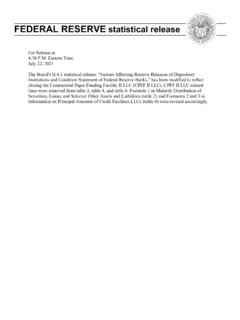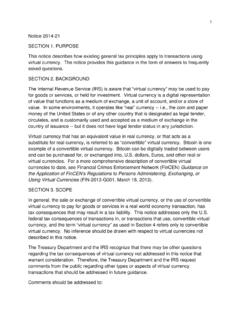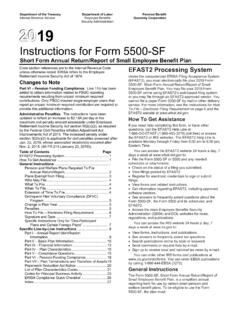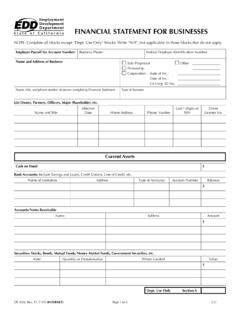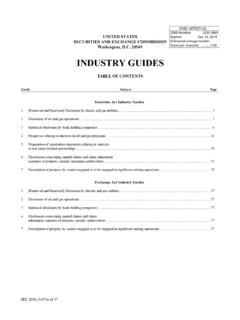Transcription of Selling your S corporation Is it now or never? - Deloitte
1 Merger & Acquisition Services M&A Insights Selling your S corporation Is it now or never? With improving corporate confidence, increasing political Another important change authorized by the 2012 tax act certainty, and strengthened balance sheets, conditions is an extension of the reduced built-in gains recognition appear to be ripe for increased merger and acquisition period from 10 years for certain sales during calendar (M&A) activity in 2013. After a few years of stockpiling years 2012 and 2013. Absent any additional tax law cash to guard against economic challenges, some changes, the recognition period for built-in gains tax will executives are starting to loosen their purse strings and revert back to 10 years after 2013, which may make it consider strategic investments, including acquisitions, more advantageous, from a tax perspective, to complete which can help them achieve their growth objectives.
2 The sale of an S corporation before December 31, 2013. Several S corporation disposition alternatives are available As a result, this could be an opportune time for that shareholders should consider when planning for the S corporation owners who are contemplating Selling their sale of the S corporation . Alternatives include a deemed businesses. However, the timing and tax structure of the asset sale technically known as a section 338(h)(10)1. sale transaction could significantly influence the value election the sale of personal goodwill, a direct asset . derived by owners and other shareholders of the company. transaction, and a direct stock transaction without a section 338(h)(10) election.
3 A quickly changing tax landscape Which transaction is in a shareholder's best interest? Are Tax law changes that passed at the end of 2010 and 2012 all shareholders treated the same? What are possible have had an impact on S corporation shareholders and deadlines for executing transactions? And what are the their business decisions. For one, as a result of the Patient potential consequences of waiting too long? Protection and Affordable Care Act of 2010, beginning in S corporation owners should carefully evaluate these 2013 certain net investment income may be subject to an options to understand their potential impact on the additional net investment income tax.
4 Additionally, economics of the transaction, tax results, and their as a result of the American Taxpayer Relief Act of 2012, individual financial objectives. Critical to this effort is the the highest marginal ordinary and capital gains rates have ability to compare the various options available so that increased effective on January 1, 2013 to and the potential tax impacts and other implications can be 20% compared to the reduced rates of 35% and15%, analyzed. respectively. 1. Unless otherwise indicated, all section references are to the Internal Revenue Code of 1986, as amended (the Code ), and all Treas. Reg references are to the Treasury Regulations promulgated under the Code, all as in effect on the date of this publication.
5 M&A Insights Selling your S corporation : Is it now or never? 1. Benefits and risks of a section 338(h)(10) election Some of the gains from a deemed asset sale may be The Tax Code allows buyers and sellers of the stock taxed at ordinary rates. For example, purchase price of an S corporation to make a section 338(h)(10) election allocated to fixed assets may result in ordinary gain due so that a qualified stock purchase will be treated as a to depreciation recapture and gains associated with the deemed asset purchase2 for federal income tax purposes. difference between the fair market value of inventory A section 338(h)(10) election is a joint election that and the tax basis may also be taxed at ordinary rates.
6 Requires agreement between and among all of the Selling On the other hand, assumption of certain liabilities shareholders and the prospective buyer. As a result of this might result in additional ordinary deductions to the election, a stock sale, for legal purposes will be treated S corporation today that were disallowed in prior years as an asset sale for tax purposes, resulting in different under the economic substance rules. It is important tax consequences for both the buyer and seller. Selling for Selling shareholders to understand these tax shareholders need to understand these tax consequences. implications, both for themselves and the buyer, before agreeing to make the election.
7 Importantly, a section 338(h)(10) election will adjust the tax basis of the S corporation 's assets in the hands of A straight stock sale may result in no state income taxes the buyer to fair market value. As a result, the buyer may owed if the Selling shareholders reside in states without enjoy incremental tax benefits, including amortization an income tax, whereas a deemed asset sale may result and depreciation of the assets' purchase price for federal in state taxes owed in the states where the income tax purposes, along with resulting future tax S corporation operates. deductions for the amount paid over the tax life of Selling shareholders will want to understand both the costs the acquired assets.
8 Associated with making a section 338(h)(10) election and The deemed asset sale treatment may have negative tax the tax benefits in the hands of the buyer. It is possible consequences that Selling shareholders need to consider. that the tax benefits may substantially outweigh the costs. By agreeing to make a section 338(h)(10) election, Selling As a result, buyers may be willing to reimburse Selling shareholders may subject themselves to various federal shareholders for any incremental costs incurred. Sellers and state taxes that a straight stock sale one without a who understand the potential benefits resulting from the section 338(h)(10) election would not generate.
9 Step-up transaction may also be in a position to negotiate a higher purchase price by clearly articulating those benefits Additionally, S corporations that sell assets within to potential buyers. 10 years of converting from a C corporation are subject to built-in gains tax. The built-in gains tax Early planning is another important consideration. imposes a corporate level tax on the portion of the S corporation shareholders should begin to weigh the gain that existed as of the C to S conversion date. benefits and risks of a section 338(h)(10) election at the Recent tax acts have provided for a temporary reduction earliest possible stages of a transaction, in most cases in the 10 year built-in gains recognition period for before a letter of intent is signed with a prospective buyer.
10 Certain sale transactions. Currently, if at least five full tax The letter of intent often contains specific terms that years of the recognition period have elapsed prior to the address the transaction structure. Both sellers and the first day of the 2012 or 2013 calendar year, then sales prospective buyer can save time, money, and resources by of assets by the S corporation are not subject to built-in making an informed decision regarding the section gains tax. 338(h)(10) election before the letter of intent is signed. 2. Generally the acquisition of 80% or more of the stock of a corporation in a 12-month period. M&A Insights Selling your S corporation : Is it now or never?











